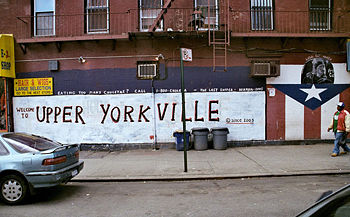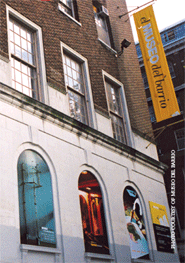| wiki | search |
Main Page | Groups and Assignments | Bios | History | Harlem | Diversity Today | Help
Puerto Ricans and African Americans in Spanish Harlem
East Harlem is a unique place because it has been the starting ground for many different immigrant groups. In addition, East Harlem has a large African American population because of its proximity to Harlem itself. Why did all these immigrants come to East Harlem? Because there weren't any where else to go. East Harlem has always been a place that was open to people who had little skills and little money. It is no secret that this is one of, if not the most, poorest parts of New York City. Irish, German, Jewish, Italian, Black, and Spanish immigrants have all settled in East Harlem at one point or another. It was the only place they could afford rent. The population dynamics of East Harlem are constantly changing because of the mentality that once you have money, you want to buy a nice house. That is what happens. As one immigrant group establish themselves financially, they want to escape poor conditions and move into wealthy neighborhoods. Today, the largest group in East Harlem is Puerto Ricans while coming in second is African Americans.
African Americans came but Puerto Ricans migrated in larger numbers and established its presence in East Harlem in the mid Twentieth Century. Their large influx came about for two reasons. For one, during the period from 1950 to 1980, there had been various immigrant restriction laws implemented to control the influx of immigrants. The second was that people from Puerto Rico were persuaded to migrate to New York where manufacturing jobs that provided better pay and better conditions awaited them. As a result, large waves of migrants settled in East Harlem. They got really comfortable and established their culture to the point where it got the name El Barrio/Spanish Harlem. However, there were problems that arose. African Americans there accepted the Puerto Ricans but the while community racialized them as Blacks. People lived in very poor conditions and the neighborhood was composed of slums and tenements before housing projects were implemented. Crime rates were high and illegal drugs were smuggled left and right. All these problems made it more of a reason for people to leave after they become well off.

For that reason, from the 1980s since the Puerto Rican population was in decline. Puerto Ricans left for safer neighborhoods in suburbs or wealthier parts of the city. Replacing them has been Mexican and other Central American ethnic Latino/a groups. A contemporary wave of immigrants from Mexico flocked to East Harlem and set up shops in stores once predominantly owned by Puerto Ricans. Gentrification and rising rent in Manhattan has seen whites find home in East Harlem for its cheaper housing. The increasingly neoliberal values of government has seen big corporations doing anything to make a profit. Neoliberalism is the increase in free market capitalism. What happens is that what used to be publicly funded are becoming privatized. For example, one aspect of El Barrio life that is being privatized is public housing. While public housing favors helping the poor and keeping rents low, private housing will favor the middle class and the youth. These are people who can pay for rent on time and pay higher rent. As a result, low income families are facing evictions and inability to pay or get help for rent. For what? to make a profit. Corporations are further commodifying the very culture of Puerto Ricans such as establishing Museums and Tourism attractions in the neighborhood. The area that once displayed Puerto Rican culture at its finest is changing rapidly. Thus, there has also been a sort of reverse-migration. It is possible to see people whose parents once lived in El Barrio to buy houses in the neighborhood. They want to reclaim their cultural past and prevent big corporations from using it as a tool to make profits. They are also returning to help the community in which they grew up, contributing intellectual, political, economic, and social capital. Even though others would never dream of returning, they are not restricted from helping their old community. A lot of people who move out still want to help because they have nostalgic connections to El Barrio. Only time and effort will tell how Spanish Harlem will look down the road.
If you are interested...
- Check out this book: Barrio Dreams by Arlene Davila - in the Gentrification and Neoliberalism of Spanish Harlem.
- Check out this book: The Tenants of East Harlem by Russell Leigh Sharman - for an indepth biography of the neighborhood of Spanish Harlem.
- Check out this book: Search of Respect by Philippe Bourgois - To learn about the dynamics on the streets including drug dealing.


